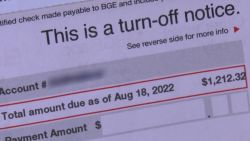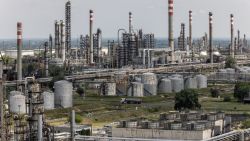A version of this story first appeared in CNN Business’ Before the Bell newsletter. Not a subscriber? You can sign up right here.
Want to know just how serious a blow the coronavirus pandemic has dealt to markets and the economy? Look at the price of oil.
On Monday, US oil to be delivered in May settled at -$37.60 per barrel, the first negative close in history. That means producers, which are running out of storage space as demand for energy collapses, are willing to pay buyers to take crude off their hands. That’s never happened before for West Texas Intermediate futures, the US benchmark.
The latest: The price of a barrel of WTI crude to be delivered in May is still below zero. The contract closes on Tuesday, which means trading is light and most investors are looking ahead to June. But the price of a barrel of WTI crude to be delivered that month is also plunging. It’s down 18% on Tuesday and is now trading below $17 per barrel. Brent crude futures, the global benchmark, dived below $20 per barrel to their lowest level since 2002.
“[I’m] shell shocked,” Bjornar Tonhaugen, head of oil markets at Rystad Energy, told me. There is normally some volatility at the end of a contract period. But this indicates that the oil market is “officially broken” as storage piles up, he said. There’s particular concern about how much space is left in Cushing, Oklahoma, the delivery hub for WTI.
The effects of dirt cheap crude will ripple through the economy. Even in a $20 oil environment, 533 US oil exploration and production companies will file for bankruptcy by the end of 2021, according to Rystad Energy.
The problem isn’t going away. No one can say when demand for oil will recover. And even once the lockdowns end, it will take some time for refineries to get back up to speed, Tonhaugen said. Similar issues could arise when the June contract comes due in a month.
“There’s a lot of oil and no real place to put it right now, so no one wants to take delivery of it,” Randy Giveans, a Jefferies analyst, told me.
Sign of the times: As onshore storage fills up, Giveans has tracked a boom in floating storage where traders and producers can stash oil to deliver at a later date for a higher price.
Over the past 10 years, traders or producers would typically spend $25,000 per day in April for a supertanker, or VLCC, which can store 2 million barrels of crude, according to Giveans. That price has now jumped to about $150,000 per day, a sixfold increase, he said.
“We’ve seen more contracts [for floating storage] in the last four weeks than for the past four years combined,” Giveans said.
Why it matters: The incredible dislocation in oil markets is a sign of just how much the coronavirus pandemic is upending investors, even as stocks have stabilized. The effects could be felt for months and years to come.
“This is very reminiscent of a time in the mid-[19]80s when exactly the same situation happened — too much supply, too little demand and prices of oil stayed low for 17 years,” former BP chief John Browne told the BBC on Tuesday.
Companies have no clue where earnings go from here
The coronavirus pandemic is creating so much uncertainty that more and more companies are withdrawing their guidance on earnings for this year, highlighting the rocky path forward for business even as countries discuss how to reopen their economies.
The latest: IBM (IBM) withdrew its full-year outlook for 2020 on Monday when it reported earnings for the January through March period. The company said it would reassess this decision at the end of the second quarter “based on the clarity of the macroeconomic recovery.”
Wells Fargo estimated earlier Monday that 98 companies in the S&P 500 had withdrawn or suspended their guidance, including McDonald’s (MCD), Walgreens (WBA), Caterpillar (CAT) and Target (TGT). That number is expected to keep growing.
The lack of forecasts makes it difficult to get too excited about the stock market’s recent gains.
Bespoke Investment Group pointed out in a recent notes to clients that the S&P 500 recovered half of the losses from its February high last week. Since the 1930s, gains of this scale have been a “very reliable signal” that the lows for the bear market have passed.
But the research group also has warned that the lack of guidance makes it difficult to be clear-eyed about current stock market valuations.
“It’s hard to blame management teams for exercising caution about how they forecast the evolution of their businesses,” the group said Monday. “But it’s also hard to square the extreme level of uncertainty from management with large cap stocks … up more than [26%] from recent lows.”
Coronavirus takes out Australia’s second biggest airline
The airline casualties of the coronavirus crisis just keep coming.
Virgin Australia has collapsed into administration, one day after billionaire founder Richard Branson made a last-ditch appeal for government support, my colleague Michelle Toh reports.
The company said Tuesday that it would kickstart bankruptcy proceedings as it looked for money to revive its business. It’s the first major airline in Asia Pacific to succumb to the loss of business from the pandemic, which has caused carriers to rip up their flight schedules, ground planes and put staff on unpaid leave. UK budget carrier Flybe collapsed last month.
The news came just hours after Branson begged the Australian government to step in. The businessman, who has already pumped $250 million into Virgin Group companies in response to the pandemic, also said he would offer his Necker Island estate in the Caribbean as collateral.
Watch this space: Virgin Atlantic, Branson’s UK-based airline, is also seeking a commercial loan from the British government, and has put staff on several months of unpaid leave.
Up next
Coca-Cola (KO), Lockheed Martin (LMT), Philip Morris (PM) and SAP (SAP) report results before US markets open. Chipotle (CMG), Netflix (NFLX), Snap (SNAP) and Texas Instruments (TXN) follow after the close.
Also today: Existing US home sales for March post at 10 a.m. ET.
Coming tomorrow: How much space is left to store oil in the United States? We’ll get the latest data on crude oil inventories.


























